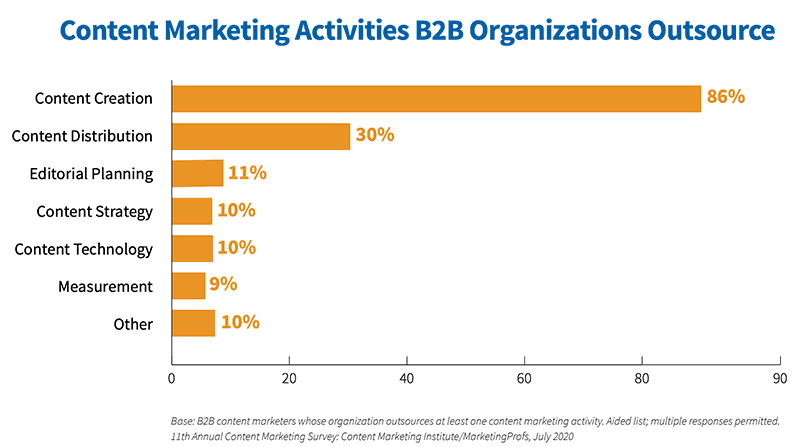As an enterprise content team, you likely develop projects in many formats. Content marketing is much more than blog posts. It’s any kind of consumable content that educates, informs, and attracts. Brands use visual content pieces to complement traditional written content and capture a buyer’s attention. Infographics are one type of visual content. These pieces can perform well but require multiple resources, time, and effort to create. So, are infographics worth it? Let’s find out.
What Does the Data Say?
To determine if infographics are worth it, it’s a good idea to look at what performance data says. First, let’s start with how marketers are using visuals and how they regard them. According to the Content Marketing Institute (CMI) B2B 11th Annual B2B Content Marketing report, 65 percent of B2B marketers use infographics.
Image: CMI
Data Points Around Performance and Engagement
The quandary with content is always—will it be engaging? It’s no secret that attention spans are short, but B2B buyers depend on content to make buying decisions, seeking out 13 pieces of content before making a decision.
Infographics can engage, as buyers are 30x more likely to read infographics than an article. They can also be very attractive for backlinks. An analysis found that posts with infographics garner 178 percent more links. This same evaluation also revealed that infographic posts receive 72 percent more views than other posts.
They are also highly shareable on social media because they are visually stimulating. They can break down complex subjects and promote statistics in a compelling way. All these pros make a case for infographics being worth the investment, but what are the challenges?
Challenges with Infographic Creation
As with any type of content creation, challenges exist in infographic production. Here are the most critical that content teams face.
Lack of Strategy
Does your content strategy address infographics and visual content? If not, then you don’t have a purpose or goals for the format. Your content strategy should include how you’ll use infographics as well as how you’ll measure their performance.
Workflows Don’t Exist
Content workflows are some of the biggest challenges that companies face. Without them, it’s hard to be consistent and meet content production goals. In the case of infographics, you have multiple resources that need to collaborate—SMEs (subject matter experts), researchers, writers, and designers.
Without proper workflows, projects will slip through the cracks or stall. The best way to resolve this issue is to use a dynamic content calendar. This tool assigns each individual task that makes up a project. It’s transparent and always up to date, so you can see where the barriers are.
Resource Concerns
Even though you’re an enterprise team, that doesn’t mean you don’t have resource issues. Since infographics often require more production resources (ex: SMEs, data analyst, writer, designer, multiple approvers, etc.), they can move slowly. Many companies outsource and engage with external resources to help with these larger assets.
Image: CMI
With outsourcing, your team has to manage external content creators, which can further complicate projects. Including contractors or freelancers in your content calendar can simplify this issue.
If outsourcing isn’t in your model, then you’ll need to work on allocation. Allocation will depend on your content production goals in terms of volume. If your goal is to create two infographics a month, you need to plan backward to ensure you meet the objective.
Another tactic to assist resource concerns is to develop a reusable template. A designer could create templates for different types of infographics. You could also use graphic design software that already includes templates, like Canva. Doing so will reduce the design time and provide a cohesive brand experience.
Ideation Challenges
Another concern around infographic development is the absence of ideas. There are some ways to spur them. Brainstorming exercises can yield lots of options. Repurposing content is another, such as taking a listicle blog post and reformatting it as an infographic.
Measuring Performance
The last obstacle of infographics is measuring their performance. Since they are somewhat different from a written blog post, content analytics often need context. Pageviews, time on page, and social shares are metrics that can gauge how effective infographics are. Using more advanced tools like heat mapping on the page can tell you more about what the viewer was looking at the most.
Other Cons of Infographics
Even though the data supports that infographics attract and engage buyers, they still have cons. Those include:
- Saturation: Your competitors and industry partners are using infographics, so standing out can be a challenge. Ingenuity and creativity are essential to differentiate your designs.
- Not mobile-friendly: Mobile currently represents 55.73 percent of web traffic, and infographics often have too many details to render well on these devices. You should look specifically at device usage for your website to understand this. This isn’t a reason to abandon infographics, but it’s something to consider.
- Statistics change: An infographic captures statistics at the time of creation. That data can become obsolete quickly. While you can easily update old blogs, changing infographics is much harder.
Are Infographics Worth It? The Final Answer Is… Yes!
Looking at performance, challenges, pros, and cons, you’ll find the resounding answer is yes, infographics are worth it. They are more consumable than long-form content, and visualization can increase retention. When executed well, they are visually eye-catching.
Standing out is somewhat tricky, but elevating infographics to be interactive could be an answer for this quandary. Any time you can get a user to participate with your content, the better it will be in converting buyers.
Having a plan for developing infographic content that includes using content calendars and content workflows will also solve many challenges.
Get More Great Content Marketing Content
If you enjoyed this post, then you’ll certainly want to subscribe to the DivvyHQ blog. It’s written by and for content marketers. Keep learning and honing your skills with our content!

